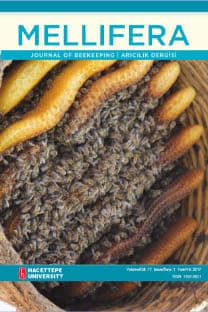The investigation of moisture and fat analysis of economically important pollen grains collected by Apis mellifera L.
Apis mellifera tarafından toplanan ekonomik önemi olan polenlerin nem ve yağ analizinin araştırılması
___
- 1. Krell, R., Value-Added Products from Beekeeping, Fao Agricultural Services Bulletin No. 124, Chapter 3, Pollen, http://www.fao.org/docrep, 1996.
- 2. Chambers, S. R., Honeybee Collected Pollen Its Harvest, Drying, Winnowing and Packaging, 1980.
- 3. Day, S., Beyer, R., Mercer, A., Ogden, S., The Nutrient Composition of Honeybee-Collected Pollen in Otago, New Zealand, Journal of Apicultural Research, 29, 3, 138-146 p., 1990.
- 4. Bonvehi, S. J., Plant Origin of Honeybee-Collected Pollen Produced in Spain, An. Asoc. Palinol. Leng. Esp. 4, 73-78 p., 1988.
- 5. Bonvehi, S. J., Jorda, E. R., Nutrient Composition and Microbiological Quality of Honeybee-Collected Pollen in Spain, Journal of Agricultural Food Chemistry, 45, 725-732 p., 1997.
- 6. Collin, S., Vanhavre , Th., Odart, E., Bouseta, A., Heat Treatment of Pollens: Impact on Their Volatile Flavor Constituents, Journal of Agricultural Food Chemistry, 43, 444-448 p., 1995.
- 7. Mossel, D. A. A., Water Relations of Foods. In International Symposium Glasgow; Duckworth, R.B., Ed.; Academic Press: London, 347-361 p., 1974.
- 8. Schmidt, J. O., Bee Products Chemical Composition and Application, Bee Products Propertie Applications and Apiterapy, 15-25 p., 1996.
- 9. Muniategui, S., Sancho, M. T., Terradillos, L. A., Huidobro, J. F., Simal-Lozano, J., New Method for Routine Pollen Analysis of Bee-Collected Pollen, Apicultural Research, 133, 3, 213-215 p., 1993.
- 10. Herbert Jr, E. W., “Honey bee nutrition”. Chapter 6, The Hive and the Honey Bee. Revised edition. Dadant & Sons, Hamilton, Illinois, 1992.
- 11. Singh, S., Saini., K. Jain, K. L. “Quantitative comparison of lipids in some pollens and their phagostimulatory effects in honey bees”. Journal of Apicultural Research, 38: 87–92, 1999.
- 12. Wodehouse, R. P., Pollen Grains, Mc Graw, Hill N. Y., 106-109 p., 1935.
- 13. Erdtman, G., Handbook of Palynology, Hafner Publishing Co., New York, 486 p., 1969.
- 14. Aytuğ, B., İstanbul Çevresi Bitkilerinin Polen Atlası, İstanbul, 330 s., 1971.
- 15. Kapp, R. O., Pollen and Spores, 249 p., 1971.
- 16. Markgraf V., D’Antoni, H. L., Pollen Flora of Argentina, The University of Arizona Press, Tucson, Arizona, 208 p., 1978.
- 17. Nilsson, S., Praglowski, J., Nilsson, L., Atlas of Airborne Pollen Grains and Spores in Northern Europe, Stockholm, 159 p., 1983.
- 18. Iwanami, Y., Sasakuma, T., Yamada, Y., Pollen : Illustrations and Scanning Electronmicrographs, 191 p., 1988.
- 19. Faegri, K., Iversen, J., Textbook of Pollen Analysis, Ed.; Faegri, K., Kaland, P. E., Krzywinski, K., John Wiley & Sons, Chichester, IV Edition, 328 p., 1989.
- 20. Moore, P. D., Webb, J. A., Collinson, M. E., Pollen Analysis, Blackwell Scientific Publications, London, U.K., 216 p., 1991.
- 21. Pehlivan, S., Türkiye’nin Alerjen Polenler Atlası, Ünal Ofset, Ankara, 191 s., 1995.
- 22. D’Albore, G. R., Textbook of Melissopalynology, Apimondia Publishing House, Bucharest, 308 p., 1997.
- 23. Swaile, B., Soxhlet Extraction of Fat from French Fries, www.terrificscience.org/lessonexchange/PACTPDF/SoxhletExtraction.pdf,2001.
- 24. Qingdian, L., Ying, L., Jianping, L., Yield and Nutritional Value of Rosa laxa Retz Pollen, Scientia Horticulturae, 71, 43-48 p., 1997.
- ISSN: 1302-5821
- Yayın Aralığı: 3
- Başlangıç: 2001
- Yayıncı: Hacettepe Üniversitesi
Effect of the propolis on the performance and carcass characteristics of growing quail
Mürsel KARABACAK, Soner ÇANKAYA, Elçin BALCI, Sibel SİLİCİ
Aslı özkök TÜYLÜ, Kadriye SORKUN
Serpil AKTAŞ, Aslı ÖZKIRIM, Nevin KESKİN
Erythrocytes functional parametres changing under apitherapy of neurological patients
V.N. KRYLOV, A. V. GOUSTOV, A. V. DERIUGINA, E. A. ANTIPENKO
